child restraint CHRYSLER ASPEN 2008 2.G Owners Manual
[x] Cancel search | Manufacturer: CHRYSLER, Model Year: 2008, Model line: ASPEN, Model: CHRYSLER ASPEN 2008 2.GPages: 479, PDF Size: 4.3 MB
Page 11 of 479
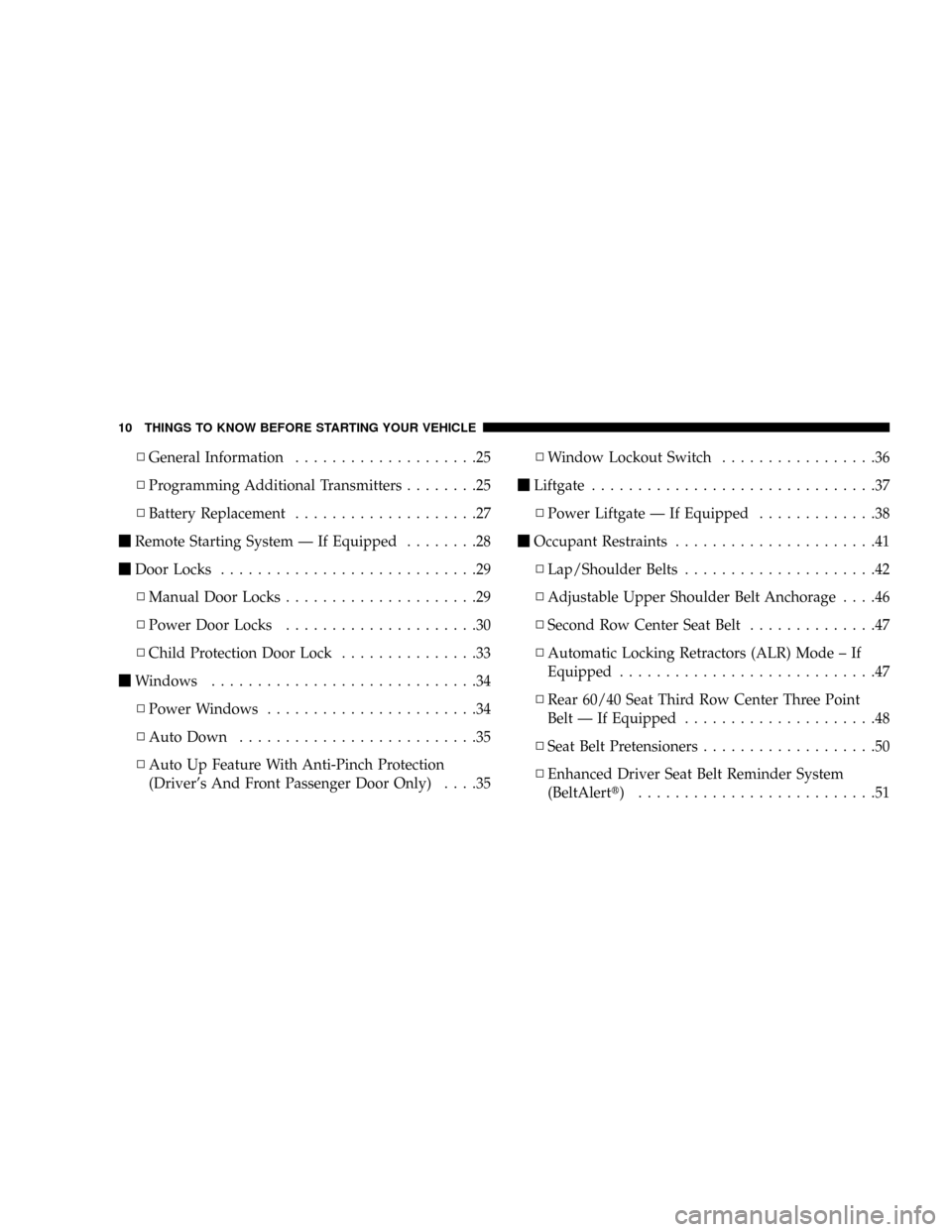
NGeneral Information....................25
NProgramming Additional Transmitters........25
NBattery Replacement....................27
mRemote Starting System Ð If Equipped........28
mDoor Locks............................29
NManual Door Locks.....................29
NPower Door Locks.....................30
NChild Protection Door Lock...............33
mWindows.............................34
NPower Windows.......................34
NAuto Down..........................35
NAuto Up Feature With Anti-Pinch Protection
(Driver's And Front Passenger Door Only)....35NWindow Lockout Switch.................36
mLiftgate...............................37
NPower Liftgate Ð If Equipped.............38
mOccupant Restraints......................41
NLap/Shoulder Belts.....................42
NAdjustable Upper Shoulder Belt Anchorage....46
NSecond Row Center Seat Belt..............47
NAutomatic Locking Retractors (ALR) Mode ± If
Equipped............................47
NRear 60/40 Seat Third Row Center Three Point
Belt Ð If Equipped.....................48
NSeat Belt Pretensioners...................50
NEnhanced Driver Seat Belt Reminder System
(BeltAlertt) ..........................51
10 THINGS TO KNOW BEFORE STARTING YOUR VEHICLE
Page 12 of 479
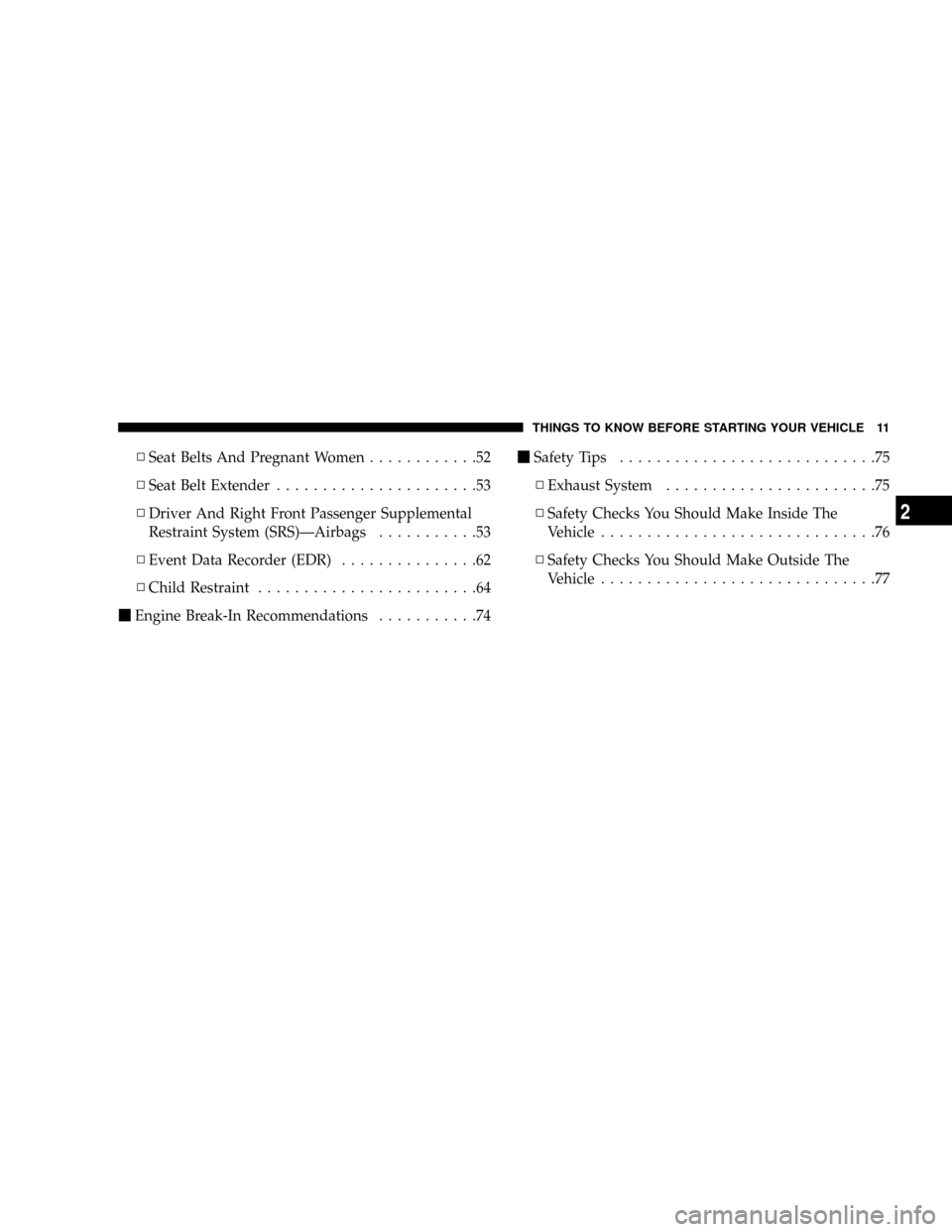
NSeat Belts And Pregnant Women............52
NSeat Belt Extender......................53
NDriver And Right Front Passenger Supplemental
Restraint System (SRS)ÐAirbags...........53
NEvent Data Recorder (EDR)...............62
NChild Restraint........................64
mEngine Break-In Recommendations...........74mSafety Tips............................75
NExhaust System.......................75
NSafety Checks You Should Make Inside The
Vehicle..............................76
NSafety Checks You Should Make Outside The
Vehicle..............................77
THINGS TO KNOW BEFORE STARTING YOUR VEHICLE 11
2
Page 42 of 479
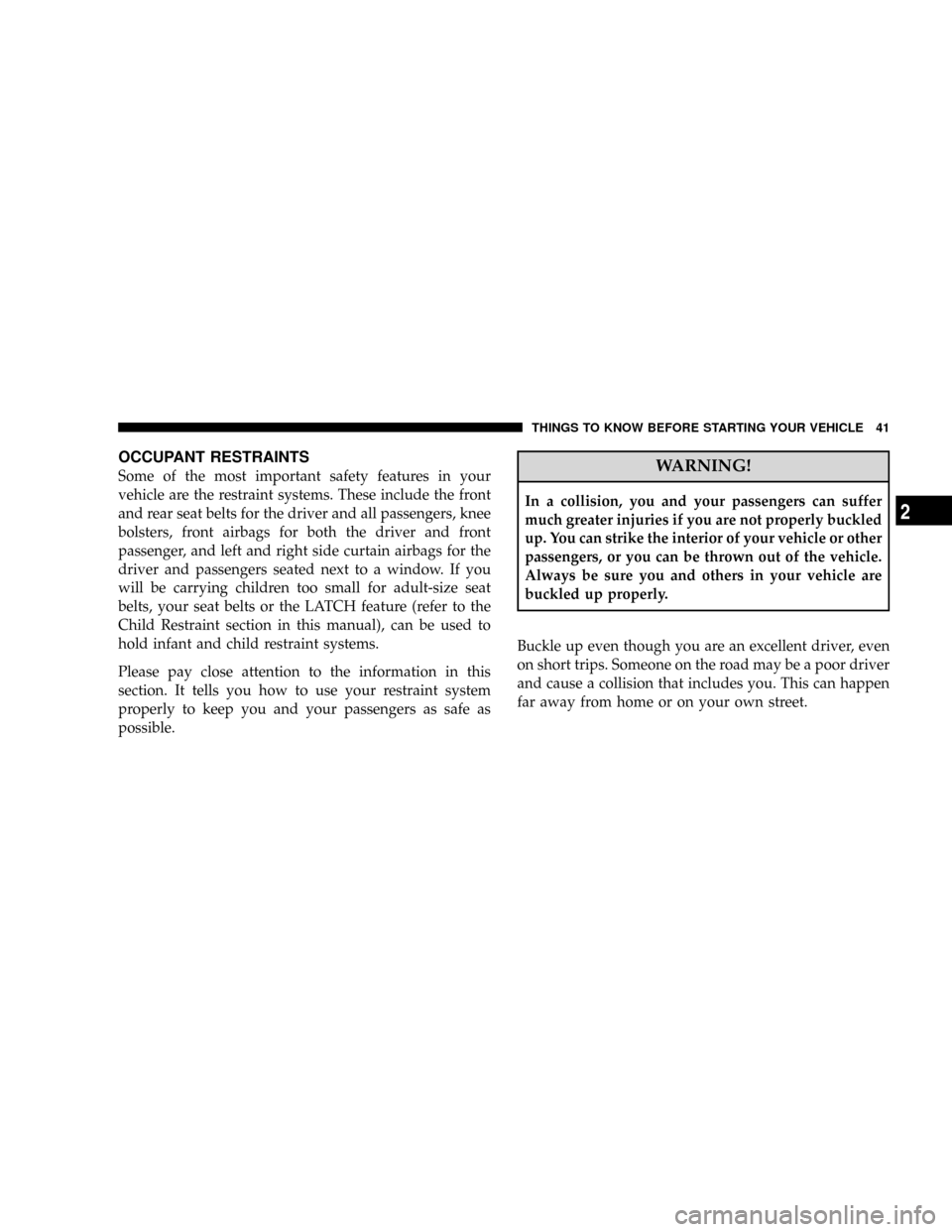
OCCUPANT RESTRAINTS
Some of the most important safety features in your
vehicle are the restraint systems. These include the front
and rear seat belts for the driver and all passengers, knee
bolsters, front airbags for both the driver and front
passenger, and left and right side curtain airbags for the
driver and passengers seated next to a window. If you
will be carrying children too small for adult-size seat
belts, your seat belts or the LATCH feature (refer to the
Child Restraint section in this manual), can be used to
hold infant and child restraint systems.
Please pay close attention to the information in this
section. It tells you how to use your restraint system
properly to keep you and your passengers as safe as
possible.WARNING!
In a collision, you and your passengers can suffer
much greater injuries if you are not properly buckled
up. You can strike the interior of your vehicle or other
passengers, or you can be thrown out of the vehicle.
Always be sure you and others in your vehicle are
buckled up properly.
Buckle up even though you are an excellent driver, even
on short trips. Someone on the road may be a poor driver
and cause a collision that includes you. This can happen
far away from home or on your own street.
THINGS TO KNOW BEFORE STARTING YOUR VEHICLE 41
2
Page 52 of 479
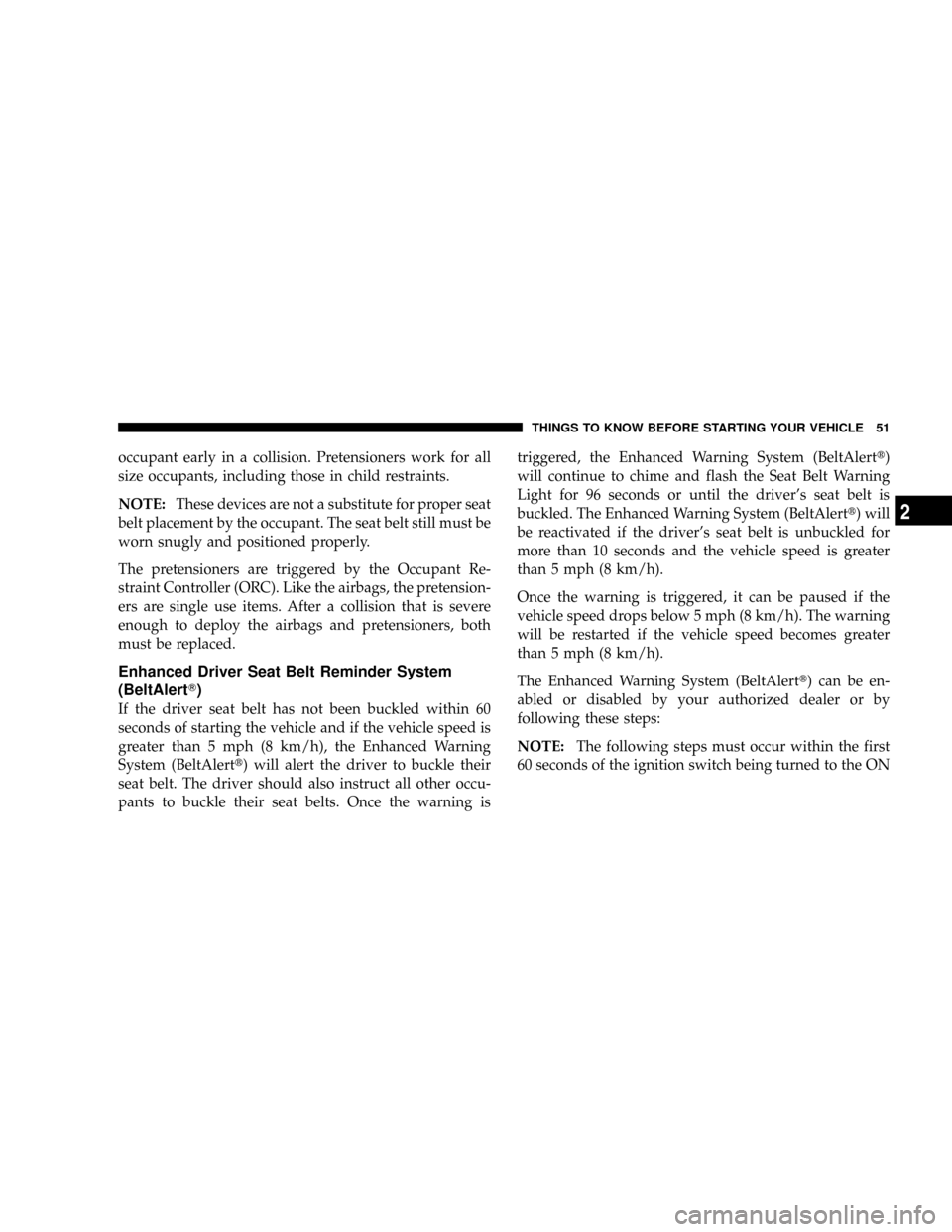
occupant early in a collision. Pretensioners work for all
size occupants, including those in child restraints.
NOTE:These devices are not a substitute for proper seat
belt placement by the occupant. The seat belt still must be
worn snugly and positioned properly.
The pretensioners are triggered by the Occupant Re-
straint Controller (ORC). Like the airbags, the pretension-
ers are single use items. After a collision that is severe
enough to deploy the airbags and pretensioners, both
must be replaced.
Enhanced Driver Seat Belt Reminder System
(BeltAlertT)
If the driver seat belt has not been buckled within 60
seconds of starting the vehicle and if the vehicle speed is
greater than 5 mph (8 km/h), the Enhanced Warning
System (BeltAlertt) will alert the driver to buckle their
seat belt. The driver should also instruct all other occu-
pants to buckle their seat belts. Once the warning istriggered, the Enhanced Warning System (BeltAlertt)
will continue to chime and flash the Seat Belt Warning
Light for 96 seconds or until the driver's seat belt is
buckled. The Enhanced Warning System (BeltAlertt) will
be reactivated if the driver's seat belt is unbuckled for
more than 10 seconds and the vehicle speed is greater
than 5 mph (8 km/h).
Once the warning is triggered, it can be paused if the
vehicle speed drops below 5 mph (8 km/h). The warning
will be restarted if the vehicle speed becomes greater
than 5 mph (8 km/h).
The Enhanced Warning System (BeltAlertt) can be en-
abled or disabled by your authorized dealer or by
following these steps:
NOTE:The following steps must occur within the first
60 seconds of the ignition switch being turned to the ON
THINGS TO KNOW BEFORE STARTING YOUR VEHICLE 51
2
Page 56 of 479
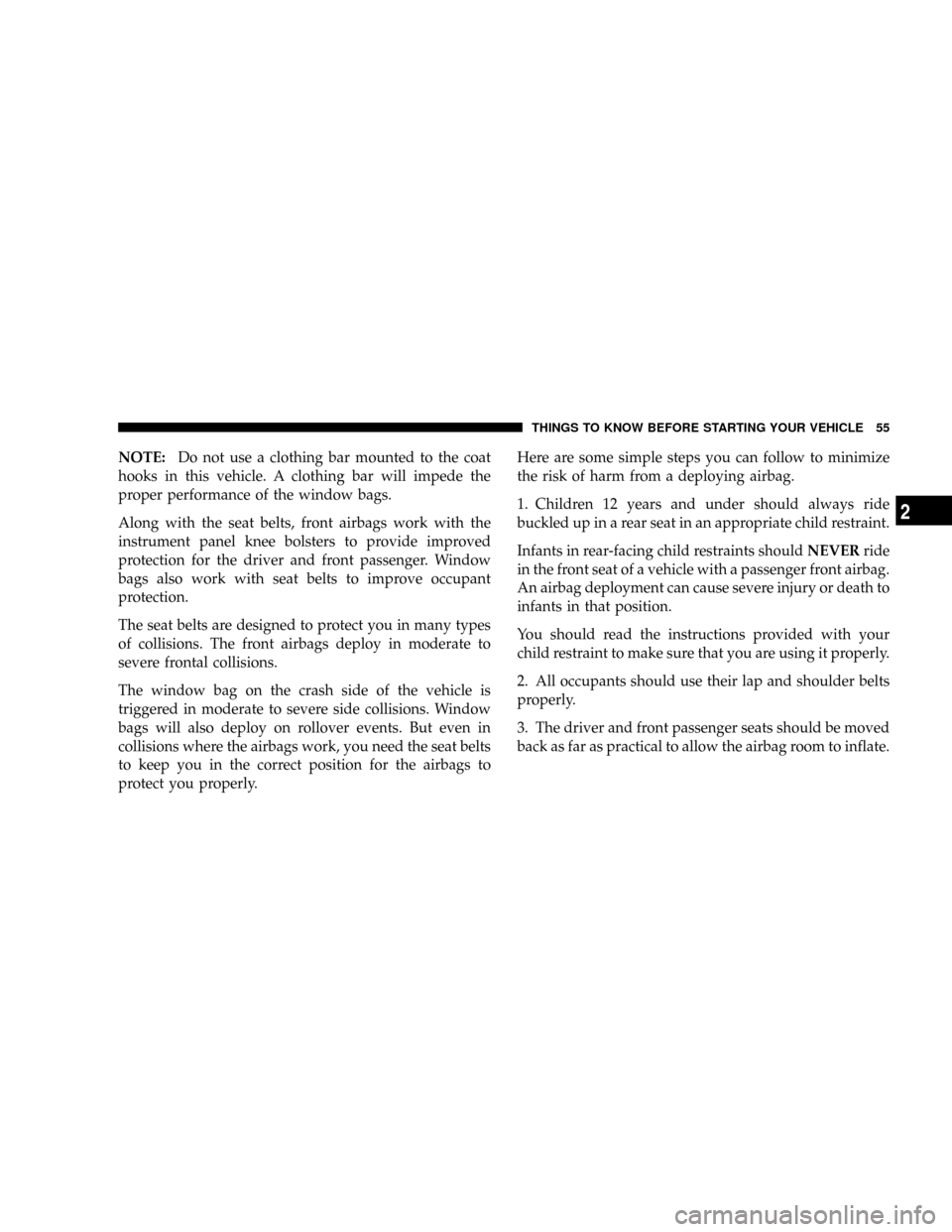
NOTE:Do not use a clothing bar mounted to the coat
hooks in this vehicle. A clothing bar will impede the
proper performance of the window bags.
Along with the seat belts, front airbags work with the
instrument panel knee bolsters to provide improved
protection for the driver and front passenger. Window
bags also work with seat belts to improve occupant
protection.
The seat belts are designed to protect you in many types
of collisions. The front airbags deploy in moderate to
severe frontal collisions.
The window bag on the crash side of the vehicle is
triggered in moderate to severe side collisions. Window
bags will also deploy on rollover events. But even in
collisions where the airbags work, you need the seat belts
to keep you in the correct position for the airbags to
protect you properly.Here are some simple steps you can follow to minimize
the risk of harm from a deploying airbag.
1. Children 12 years and under should always ride
buckled up in a rear seat in an appropriate child restraint.
Infants in rear-facing child restraints shouldNEVERride
in the front seat of a vehicle with a passenger front airbag.
An airbag deployment can cause severe injury or death to
infants in that position.
You should read the instructions provided with your
child restraint to make sure that you are using it properly.
2. All occupants should use their lap and shoulder belts
properly.
3. The driver and front passenger seats should be moved
back as far as practical to allow the airbag room to inflate.
THINGS TO KNOW BEFORE STARTING YOUR VEHICLE 55
2
Page 60 of 479
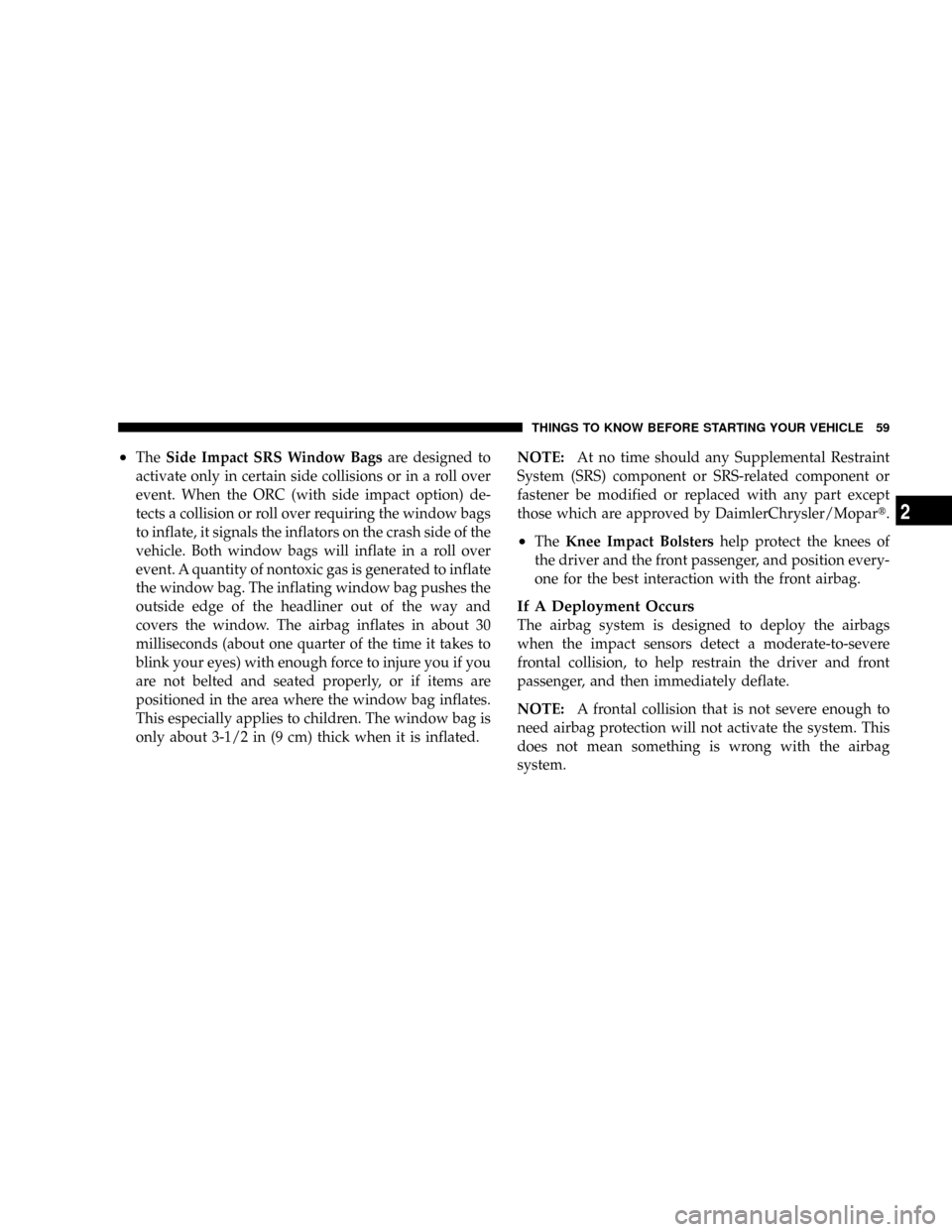
²TheSide Impact SRS Window Bagsare designed to
activate only in certain side collisions or in a roll over
event. When the ORC (with side impact option) de-
tects a collision or roll over requiring the window bags
to inflate, it signals the inflators on the crash side of the
vehicle. Both window bags will inflate in a roll over
event. A quantity of nontoxic gas is generated to inflate
the window bag. The inflating window bag pushes the
outside edge of the headliner out of the way and
covers the window. The airbag inflates in about 30
milliseconds (about one quarter of the time it takes to
blink your eyes) with enough force to injure you if you
are not belted and seated properly, or if items are
positioned in the area where the window bag inflates.
This especially applies to children. The window bag is
only about 3-1/2 in (9 cm) thick when it is inflated.NOTE:At no time should any Supplemental Restraint
System (SRS) component or SRS-related component or
fastener be modified or replaced with any part except
those which are approved by DaimlerChrysler/Mopart.
²TheKnee Impact Bolstershelp protect the knees of
the driver and the front passenger, and position every-
one for the best interaction with the front airbag.
If A Deployment Occurs
The airbag system is designed to deploy the airbags
when the impact sensors detect a moderate-to-severe
frontal collision, to help restrain the driver and front
passenger, and then immediately deflate.
NOTE:A frontal collision that is not severe enough to
need airbag protection will not activate the system. This
does not mean something is wrong with the airbag
system.
THINGS TO KNOW BEFORE STARTING YOUR VEHICLE 59
2
Page 65 of 479
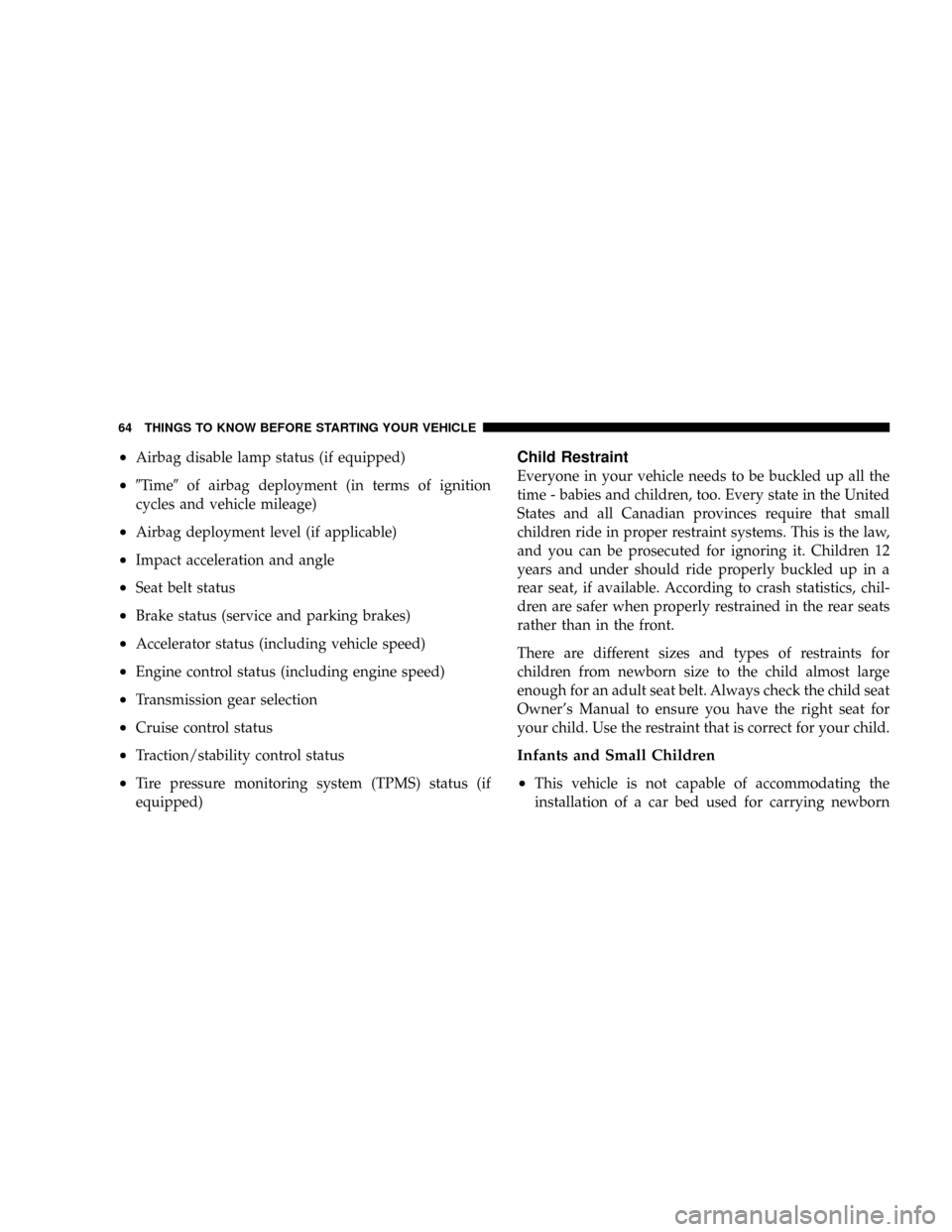
²Airbag disable lamp status (if equipped)
²9Time9of airbag deployment (in terms of ignition
cycles and vehicle mileage)
²Airbag deployment level (if applicable)
²Impact acceleration and angle
²Seat belt status
²Brake status (service and parking brakes)
²Accelerator status (including vehicle speed)
²Engine control status (including engine speed)
²Transmission gear selection
²Cruise control status
²Traction/stability control status
²Tire pressure monitoring system (TPMS) status (if
equipped)
Child Restraint
Everyone in your vehicle needs to be buckled up all the
time - babies and children, too. Every state in the United
States and all Canadian provinces require that small
children ride in proper restraint systems. This is the law,
and you can be prosecuted for ignoring it. Children 12
years and under should ride properly buckled up in a
rear seat, if available. According to crash statistics, chil-
dren are safer when properly restrained in the rear seats
rather than in the front.
There are different sizes and types of restraints for
children from newborn size to the child almost large
enough for an adult seat belt. Always check the child seat
Owner's Manual to ensure you have the right seat for
your child. Use the restraint that is correct for your child.
Infants and Small Children
²
This vehicle is not capable of accommodating the
installation of a car bed used for carrying newborn
64 THINGS TO KNOW BEFORE STARTING YOUR VEHICLE
Page 66 of 479
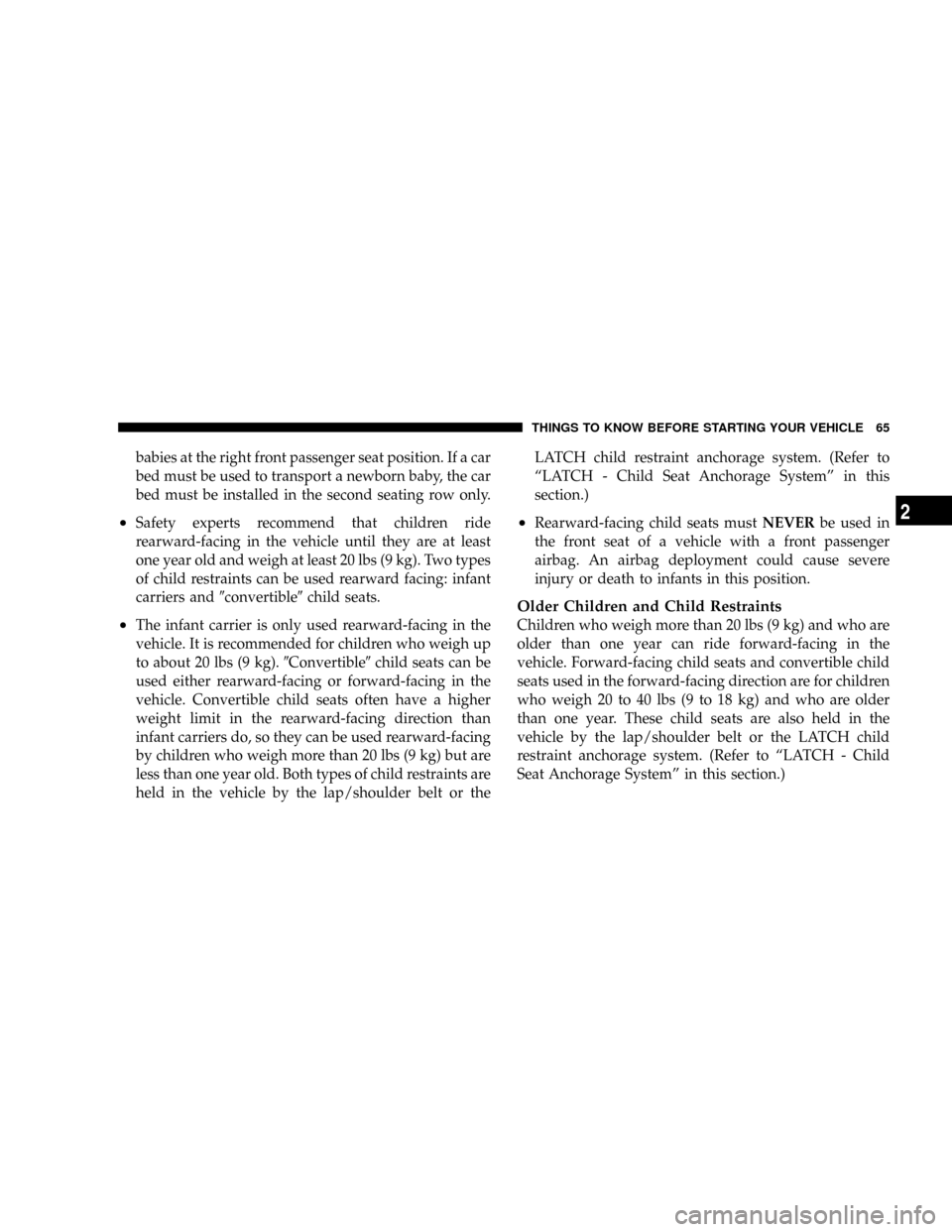
babies at the right front passenger seat position. If a car
bed must be used to transport a newborn baby, the car
bed must be installed in the second seating row only.
²Safety experts recommend that children ride
rearward-facing in the vehicle until they are at least
one year old and weigh at least 20 lbs (9 kg). Two types
of child restraints can be used rearward facing: infant
carriers and9convertible9child seats.
²The infant carrier is only used rearward-facing in the
vehicle. It is recommended for children who weigh up
to about 20 lbs (9 kg).9Convertible9child seats can be
used either rearward-facing or forward-facing in the
vehicle. Convertible child seats often have a higher
weight limit in the rearward-facing direction than
infant carriers do, so they can be used rearward-facing
by children who weigh more than 20 lbs (9 kg) but are
less than one year old. Both types of child restraints are
held in the vehicle by the lap/shoulder belt or theLATCH child restraint anchorage system. (Refer to
ªLATCH - Child Seat Anchorage Systemº in this
section.)
²Rearward-facing child seats mustNEVERbe used in
the front seat of a vehicle with a front passenger
airbag. An airbag deployment could cause severe
injury or death to infants in this position.
Older Children and Child Restraints
Children who weigh more than 20 lbs (9 kg) and who are
older than one year can ride forward-facing in the
vehicle. Forward-facing child seats and convertible child
seats used in the forward-facing direction are for children
who weigh 20 to 40 lbs (9 to 18 kg) and who are older
than one year. These child seats are also held in the
vehicle by the lap/shoulder belt or the LATCH child
restraint anchorage system. (Refer to ªLATCH - Child
Seat Anchorage Systemº in this section.)
THINGS TO KNOW BEFORE STARTING YOUR VEHICLE 65
2
Page 67 of 479
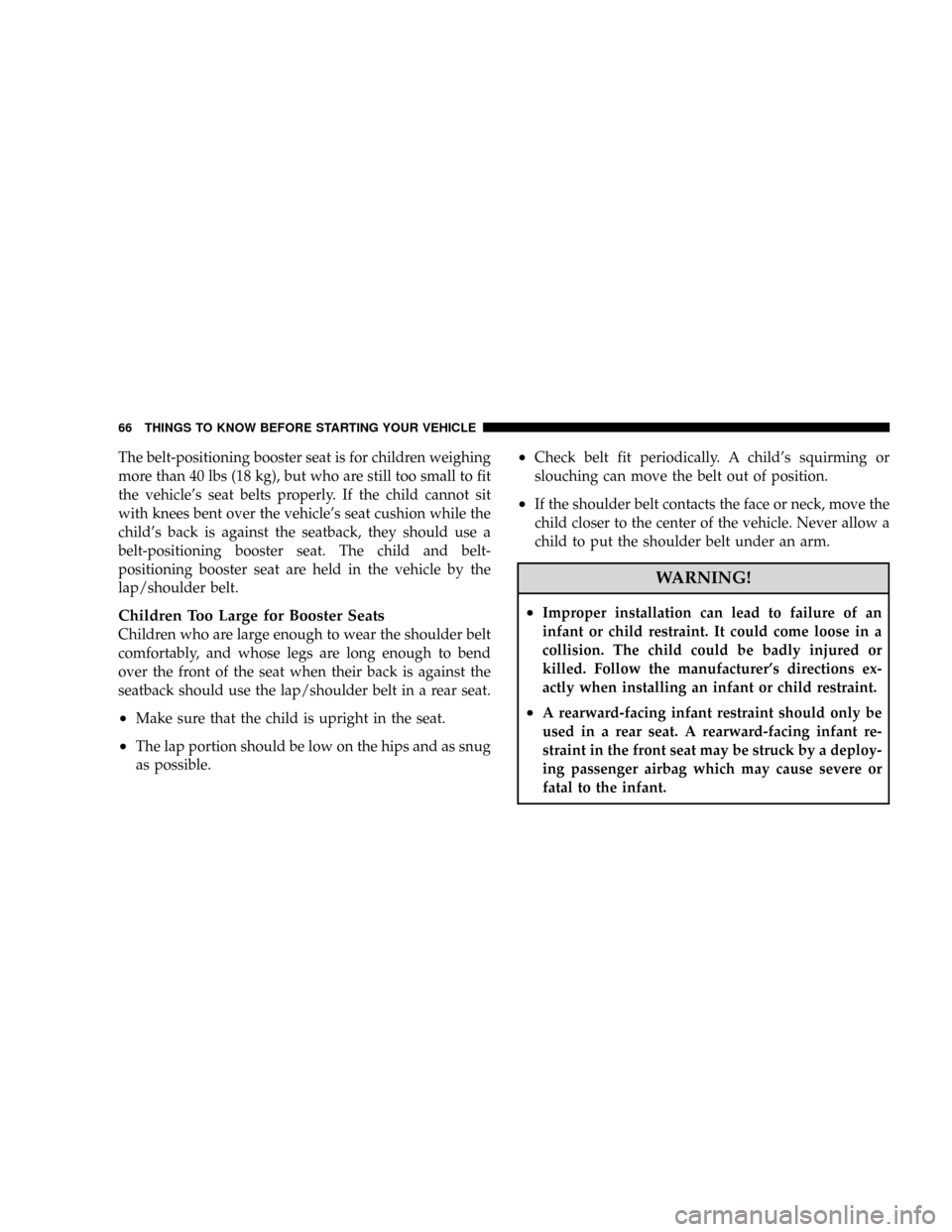
The belt-positioning booster seat is for children weighing
more than 40 lbs (18 kg), but who are still too small to fit
the vehicle's seat belts properly. If the child cannot sit
with knees bent over the vehicle's seat cushion while the
child's back is against the seatback, they should use a
belt-positioning booster seat. The child and belt-
positioning booster seat are held in the vehicle by the
lap/shoulder belt.
Children Too Large for Booster Seats
Children who are large enough to wear the shoulder belt
comfortably, and whose legs are long enough to bend
over the front of the seat when their back is against the
seatback should use the lap/shoulder belt in a rear seat.
²Make sure that the child is upright in the seat.
²The lap portion should be low on the hips and as snug
as possible.
²Check belt fit periodically. A child's squirming or
slouching can move the belt out of position.
²If the shoulder belt contacts the face or neck, move the
child closer to the center of the vehicle. Never allow a
child to put the shoulder belt under an arm.
WARNING!
²Improper installation can lead to failure of an
infant or child restraint. It could come loose in a
collision. The child could be badly injured or
killed. Follow the manufacturer's directions ex-
actly when installing an infant or child restraint.
²A rearward-facing infant restraint should only be
used in a rear seat. A rearward-facing infant re-
straint in the front seat may be struck by a deploy-
ing passenger airbag which may cause severe or
fatal to the infant.
66 THINGS TO KNOW BEFORE STARTING YOUR VEHICLE
Page 68 of 479
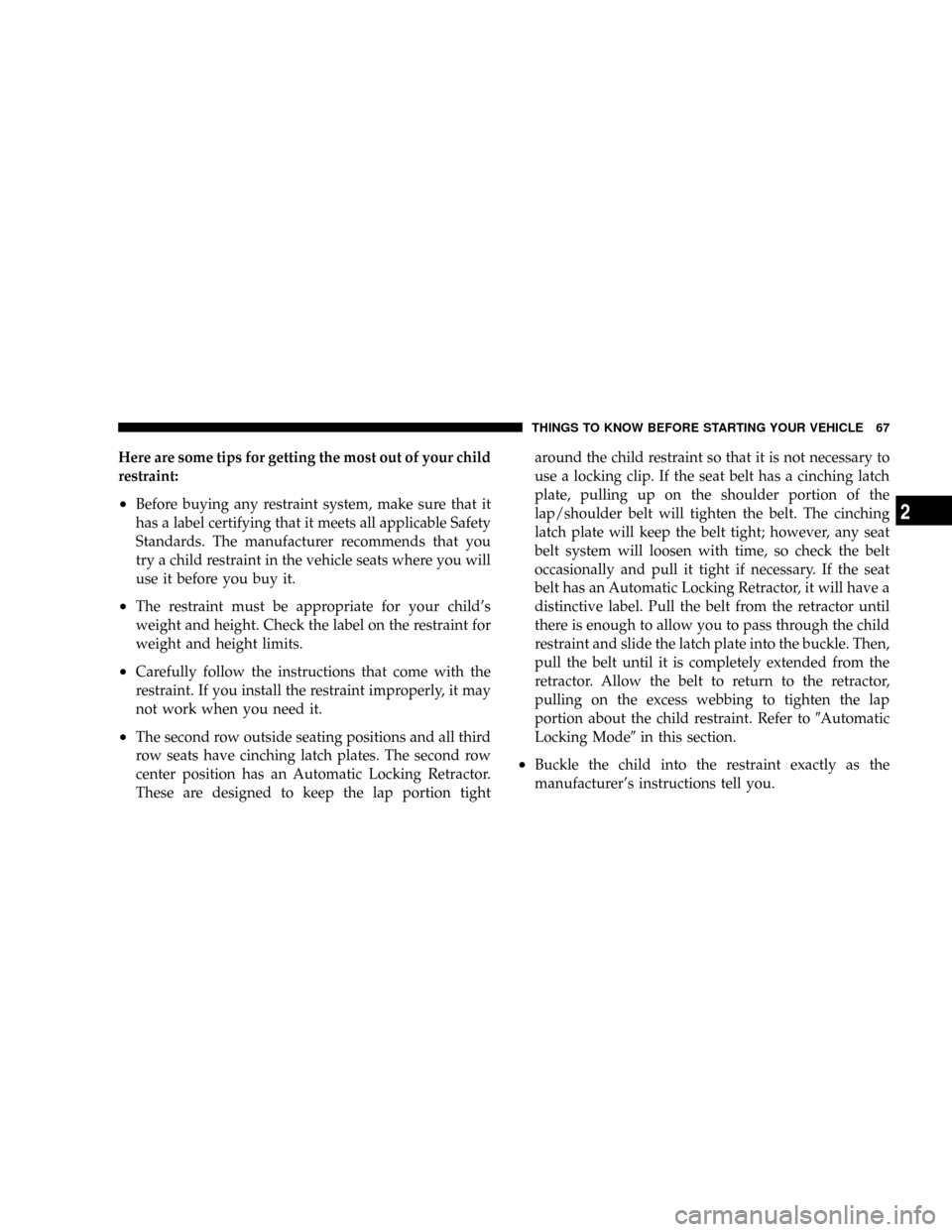
Here are some tips for getting the most out of your child
restraint:
²Before buying any restraint system, make sure that it
has a label certifying that it meets all applicable Safety
Standards. The manufacturer recommends that you
try a child restraint in the vehicle seats where you will
use it before you buy it.
²The restraint must be appropriate for your child's
weight and height. Check the label on the restraint for
weight and height limits.
²Carefully follow the instructions that come with the
restraint. If you install the restraint improperly, it may
not work when you need it.
²The second row outside seating positions and all third
row seats have cinching latch plates. The second row
center position has an Automatic Locking Retractor.
These are designed to keep the lap portion tightaround the child restraint so that it is not necessary to
use a locking clip. If the seat belt has a cinching latch
plate, pulling up on the shoulder portion of the
lap/shoulder belt will tighten the belt. The cinching
latch plate will keep the belt tight; however, any seat
belt system will loosen with time, so check the belt
occasionally and pull it tight if necessary. If the seat
belt has an Automatic Locking Retractor, it will have a
distinctive label. Pull the belt from the retractor until
there is enough to allow you to pass through the child
restraint and slide the latch plate into the buckle. Then,
pull the belt until it is completely extended from the
retractor. Allow the belt to return to the retractor,
pulling on the excess webbing to tighten the lap
portion about the child restraint. Refer to9Automatic
Locking Mode9in this section.
²Buckle the child into the restraint exactly as the
manufacturer's instructions tell you.
THINGS TO KNOW BEFORE STARTING YOUR VEHICLE 67
2